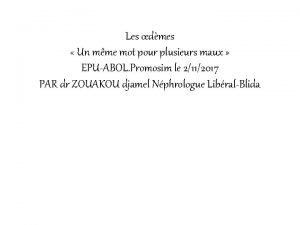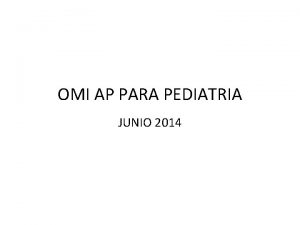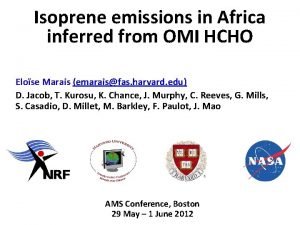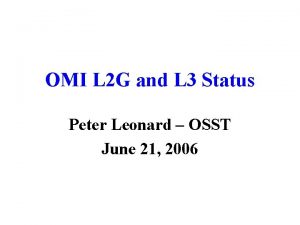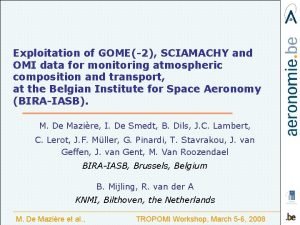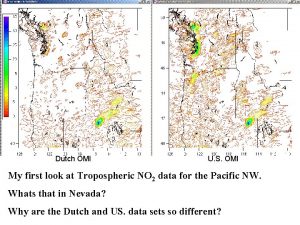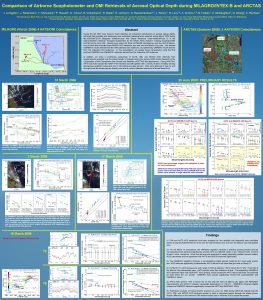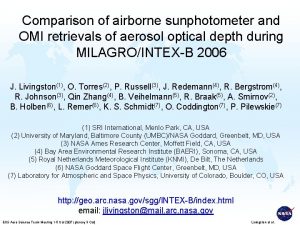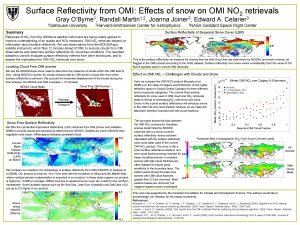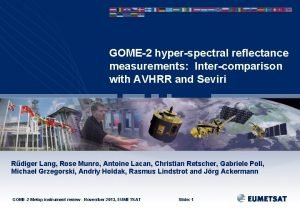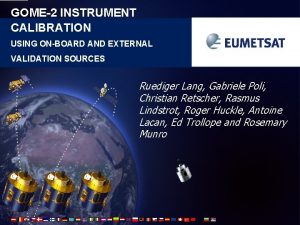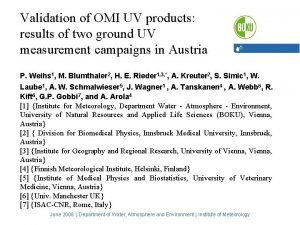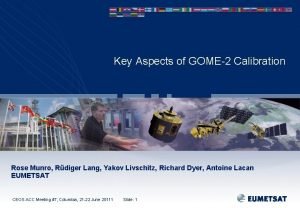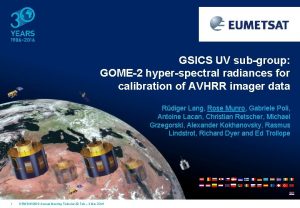Comparison of GOME2 and OMI surface UV products











- Slides: 11

Comparison of GOME-2 and OMI surface UV products Niilo Kalakoski, Finnish Meteorological Institute

O 3 M SAF Offline UV Product • Satellite Application Facility on Ozone and Atmospheric Chemistry Monitoring (O 3 M SAF) • Joint effort of 10 institutes in 7 European countries, FMI is the leading entity • Part of EUMETSAT’s Polar System (EPS) ground segment • 3 Metop satellites to cover some 15 years up to 2020 • Metop-A was successfully launched 19 October 2006 • Ozone, trace gases and aerosols from GOME-2 • Offline Surface UV (OUV) Product: • Developed and processed at FMI • Contains • Daily (integrated) doses • Daily maximum dose rates • Biological weightings: • • • Erythemal (CIE) DNA damage Generalized Plant Response SCUP-h 0. 5 x 0. 5 degree grid, HDF 5 format Currently demonstrational status

O 3 M SAF OUV: Inputs • Inputs: Total Ozone • GOME-2 NRT Total Ozone (NTO) product • Produced by the German Aerospace Center (DLR) within the O 3 M SAF • Read from EUMETCast broadcasting, 2. 5 hours from sensing • Used in modelling of surface UV irradiance and AVHRR channel 1 reflectance • Inputs: Surface albedo: • Static regions (no seasonal variability): • TOMS 380 nm MLER • Dynamic regions (seasonal snow or ice): • Climatology of A. Tanskanen • Inputs: Aerosols: • Currently: Global Aerosol Dataset GADS • Testing with Aerocom climatology

O 3 M SAF OUV: Cloud Optical Depth Data • Inputs: AVHRR ch. 1 (630 nm) reflectances • exploits the synergy between Metop and NOAA satellites • Data readily available from EUMETCast • At least 2 cloud observations per day obtained globally • Morning (9: 30): Metop-A • Afternoon (14: 30): NOAA-18 • Using both morning and afternoon observations improves the daily dose integration • Currently no cloud retrieval if • solar zenith angle > 70 degrees • surface albedo > 60 %

O 3 M SAF OUV vs. OMI UV Main Differences O 3 M SAF OUV OMI UV Total Ozone source GOME-2 / Metop OMI / Aura Wavelength of cloud optical depth retrieval AVHRR 630 nm OMI 360 nm Cloud observations per >= 2 daily dose integration Daily dose frequency Surface albedo Aerosols 1 1 per day, in 0. 5 x 0. 5° grid multiple (and different) values per day, for each orbit No seasonal snow or ice: Tanskanen et al. TOMS 380 nm MLER climatology Seasonal snow or ice: Tanskanen et al. Climatology GADS (soon: Aerocom) None (soon: Aerocom)

Comparisons of OUV and OMIuv • Surface UV radiation in k. J/m 2 from OMI (left) and GOME-2 (right) for February 1 st 2008. • GOME-2 UV not retrieved for SZA > 70 degrees

OUV – OMIuv absolute difference in k. J/m 2

(OUV-OMI)/OMI relative difference

• Time series of the surface UV from OMI and GOME-2 compared to ground-based measurements • CIE erythemal daily dose • Jokioinen (above) and Sodankylä (below) • August 2007

• Scatterplot comparisons of OMIuv and OUV CIE erythemal daily doses • Jokioinen (above) and Sodankylä (below) • From June 1 st 2007 to May 31 st 2008 k. J/m 2 Jokioinen Sodankylä OUV-OMI mean error -0. 09 -0. 03 OUV-ground standard deviation 0, 20 0. 19 OUV-ground mean error 0. 09 0. 15 OMI-ground standard deviation 0. 40 0. 36 OMI-ground mean error 0. 19 0. 18

Thank you for your attention!
